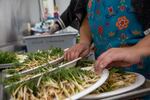
Confederated Tribes of the Umatilla Indian Reservation members prepare plates of celery for one of the tribes' First Foods feast at the Nixyáawii Longhouse, in this provided photo.
Annie Warren / CTUIR
The Confederated Tribes of the Umatilla Indian Reservation will initiate a first-of-its-kind food waste reduction project this spring.
The campaign, titled “Nixyáawii, Don’t Throw it Away!” (pronounced “Nic-YAH-way”), will be the first coordinated food waste reduction effort the tribal government has initiated.
Through the initiative, which is partly funded with a $172,000 grant from the U.S. Department of Agriculture, the tribe’s Department of Natural Resources will look to calculate how much food waste the community generates. It will also develop resources and offer educational opportunities for the tribal community on how to reduce the amount of food that ends up in landfills.
The tribe will also install a small biodigester, which will use bacteria to break down organic material in the absence of air — referred to as an anaerobic environment — and turn it to methane for cooking and fertilizer for the tribe’s community garden.
The U.S. EPA estimates each year gasses produced by food waste equal 170 million metric tons of carbon dioxide released into the atmosphere. A significant amount of methane and nitrous oxide also get into the atmosphere.
Colleen Sanders, the climate adaptation planner for the tribe, said the initiative serves as a way to capture gas emissions generated by food, rather than let it go into the atmosphere.
“When decomposition happens without oxygen, it creates methane,” Sanders said. “And this methane in landfills gets built up in these pockets of food waste. And then when there’s a shift in the waste, it gets released out into the atmosphere where it makes its way into our environment.”
Part of the reason the tribe is pursuing the project now is in response to former Gov. Kate Brown’s 2020 executive order to curb Oregon’s greenhouse gas emissions, which included a goal of reducing food waste by 50% by 2030, said DeArcie Abraham, who runs Biowaste Technologies and will operate the biodigester in partnership with the tribe’s department of natural resources.
“Food waste is a huge one, never touching soil or having oxygen it will sit there for 20 years to decompose,” Abraham said. “The project will demonstrate that food waste is a resource and not a waste product that’s worthless.”
The project will mostly focus on the Mission area of the reservation, which is the site of the tribal headquarters, including the Nixyáawii Longhouse, where several tribal ceremonies are held.
The tribe’s First Foods, like salmon, roots and berries, are a significant part of the creation story. But during ceremonial feasts, they sometimes get thrown away, said Althea Huesties-Wolf, the First Foods policy program manager.
“And so it was just another reason to get this digester project going,” Huesties-Wolf said. “Those first foods will continue to be treated with respect because they’re gonna turn into compost and come back into the land. They’re not gonna get stuck in a landfill.”
Sanders said the two-year pilot project has a lot of potential, and it could be used as a template to expand into other communities within the reservation and ultimately change the community’s perception of food.
“Everybody knows that when you are making food at home if you have a carrot that’s got an ugly spot, you cut the ugly spot off, and that usually goes into the garbage can, but it doesn’t have to,” Sanders said. “But we’re hoping by the end of this project that they will cut that ugly spot off that carrot and say ‘I am so excited for the future that this ugly spot on this carrot can have.’”
